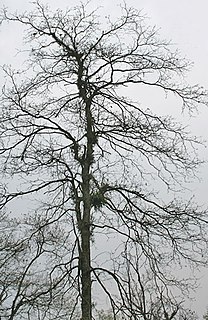
Terminalia is a genus of large trees of the flowering plant family Combretaceae, comprising around 100 species distributed in tropical regions of the world. This genus gets its name from Latin terminus, referring to the fact that the leaves appear at the very tips of the shoots.

Terminalia catappa is a large tropical tree in the leadwood tree family, Combretaceae, that grows mainly in the tropical regions of Asia, Africa, and Australia. Common names in English include country almond, Indian almond, Malabar almond, sea almond, tropical almond, beach almond and false kamani.
Terminalia ferdinandiana, also called the gubinge, billygoat plum, Kakadu plum, green plum, salty plum, murunga or mador, is a flowering plant in the family Combretaceae, native to Australia, widespread throughout the tropical woodlands from northwestern Australia to eastern Arnhem Land. It has a high concentration of vitamin C in its fruit: recorded concentrations of 2300–3150 mg/100 g wet weight and occasionally as high as 5300 mg/100 g, compared with 50 mg/100 g for oranges, ranks among the highest known of any natural source.

Terminalia chebula, commonly known as black- or chebulic myrobalan, is a species of Terminalia, native to South Asia from India and Nepal east to southwest China (Yunnan), and south to Sri Lanka, Malaysia, and Vietnam.

Terminalia paniculata is a tree native to southwest India. Known in the timber trade as kindal, it has a variety of names in local languages.

Terminalia carpentariae, the wild peach, is a shrub or tree in the family Combretaceae. The species is native to northern Australia, occurring on sandy soils and coastal dunes. The edible fruits are harvested in the wild. The species was formally described in 1950 by botanist Cyril Tenison White. The type specimen was collected in the Crocodile Islands in the Northern Territory.
Terminalia microcarpa is a tree species in the family Combretaceae. It occurs in Indonesia, Malaysia, the Philippines, Papua New Guinea and Australia.
Terminalia petiolaris, commonly known as blackberry tree or billygoat plum, or marool in the local Bardi language, is a species of plant in the Combretaceae family. It is endemic to the coast of the Kimberley region of northern Western Australia.
Terminalia arostrata, commonly known as crocodile tree or nutwood, is a tree of the family Combretaceae native to northern parts of Australia.
Terminalia bursarina, commonly known as bendee, is a tree of the family Combretaceae native to northern parts of Australia.
Terminalia canescens, commonly known as joolal or winged nut tree, is a tree of the family Combretaceae native to northern parts of Australia.
Terminalia circumalata, is a tree of the family Combretaceae. It is endemic to Western Australia. It is found in the Pilbara region of Western Australia.
Terminalia cunninghamii, commonly known as pindan quondong, pindan walnut or kalumburu almond, is a tree or shrub of the family Combretaceae native to Western Australia. Indigenous people know the plant as kumpaja.
Terminalia fitzgeraldii is a tree of the family Combretaceae native to Western Australia.
Terminalia grandiflora, commonly known as yalu, plumwood or nutwood, is a tree of the family Combretaceae native to northern Australia. The Nungali and Jaru peoples know the tree as badgari and the Wagiman know it as barnyin.

Terminalia hadleyana is a tree of the family Combretaceae native to northern Australia.
Terminalia latipes is a tree of the family Combretaceae native to northern Australia.
Terminalia platyphylla, commonly known as wild plum, is a tree of the family Combretaceae native to northern Australia.
Terminalia platyptera is a tree of the family Combretaceae native to northern Australia.
Terminalia volucris, commonly known as rosewood, is a tree of the family Combretaceae native to northern Australia.






